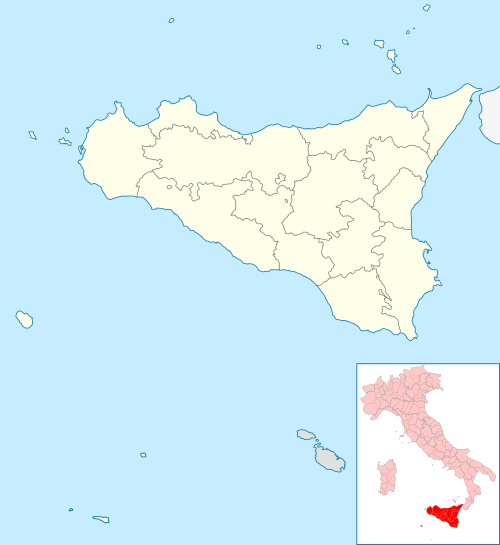Bronte, Sicily
Bronte is a town and comune in the Metropolitan City of Catania, in Sicily, southern Italy. The town is situated approximately 16 kilometres (10 mi) west-northwest from Mount Etna, on the side of the valley of the Simeto river, and about 32 kilometres (20 mi) west from Giarre and Sicily's eastern coast. Bronte's economy relies mostly on farming, particularly of pistachio nuts.
Bronte | |
|---|---|
| Comune di Bronte | |
 | |
-Stemma.png) Coat of arms | |
Location of Bronte 
| |
 Bronte Location of Bronte in Italy  Bronte Bronte (Sicily) | |
| Coordinates: 37°47′N 14°50′E | |
| Country | Italy |
| Region | Sicily |
| Metropolitan city | Catania (CT) |
| Government | |
| • Mayor | Graziano Calanna |
| Area | |
| • Total | 249 km2 (96 sq mi) |
| Elevation | 760 m (2,490 ft) |
| Population (30 April 2017)[2] | |
| • Total | 19,074 |
| • Density | 77/km2 (200/sq mi) |
| Demonym(s) | Brontesi |
| Time zone | UTC+1 (CET) |
| • Summer (DST) | UTC+2 (CEST) |
| Postal code | 95034 |
| Dialing code | 095 |
| Patron saint | St. Blaise |
| Saint day | 3 February |
| Website | Official website |
History
Bronte's name derives from that of one of the Cyclopes in Greek mythology and it means "The Thunderer". Legend has it that the Cyclopes lived under Mount Etna.
In 1520 Charles V united the twenty-four hamlets of the surrounding area, which formed the town of Bronte. Mount Etna nearly destroyed the town three times, in 1651, in 1832, and finally in 1843.
In 1799, King Ferdinand III created Bronte as a Duchy, and rewarded admiral Horatio Nelson with the title of Duke for the help he had provided him in suppressing the revolution in Naples and so in recovering his throne. As well as being made a Duke, Nelson was given as a fief the Castello Maniace, which at the time was the remains of a Benedictine Monastery. The Castle passed into the Bridport family when the 1st Viscount Bridport married the then Duchess of Bronte, who was Admiral Nelson's niece. The Bridports continued to live in the castle until 1982 when the current Viscount sold the property to the Comune of Bronte. Today it is a local tourist attraction in Maniace, and has been restored (including the recreation of ceramic-tiled floors) by the Comune. It is built in the style of an English country house (with formal garden) set in the hills of eastern Sicily.[3]
In 1860, during Giuseppe Garibaldi's Expedition of the thousand, there was a citizen's revolt. Sicilian peasants had hoped for - and did not get from Garibaldi - reforms from the restrictive conditions imposed by noble landowners. This hope had been reinforced by Garibaldi's decree of 2 June 1860 that land would be re-distributed. The southerners revolted in several localities, and at Bronte on August 4, 1860, Garibaldi's friend and general Girolamo ("Nino") Bixio bloodily repressed one of these uprisings with two battalions of Redshirts, massacring more than a dozen, peasants and nobles alike, and putting the torch to the town theater and municipal archives.[4] Bixio ordered a kangaroo court and had five Bronteans summarily shot, all of which earned him the sobriquet "the Butcher of Bronte".
Main sights
- Castello Nelson – a museum about 7 miles (11 km) north from the town center. Originally an abbey dating to 1174, it has a Gothic-Norman portico and contains a Byzantine icon which, according to tradition, was painted by St Luke.
- Church of the Annunziata (1535)
- Collegio Capizzi (1774–1779)
Twin towns
References
- "Superficie di Comuni Province e Regioni italiane al 9 ottobre 2011". Istat. Retrieved 16 March 2019.
- "Popolazione Residente al 1° Gennaio 2018". Istat. Retrieved 16 March 2019.
- Hibbert, Christopher (1995). Nelson: A Personal History. Penguin Books. p. 195.
- Chisholm 1911.
Sources
- Pratt, Michael (2006); Nelson's Duchy: A Sicilian Anomaly, Spellmount Publishers Ltd. ISBN 186227326X
- Fleming, Ian. Thunderball. (1961) Penguin Group. ISBN 0-141-02828-9. P-076